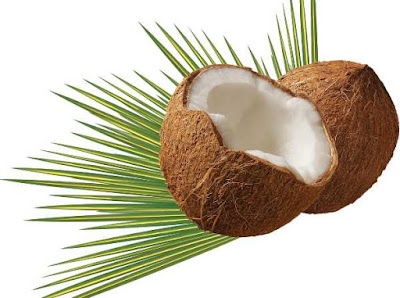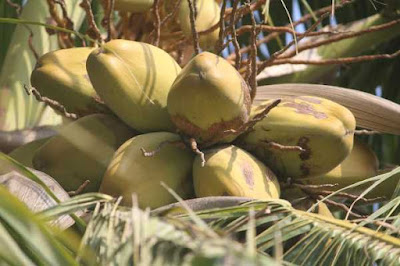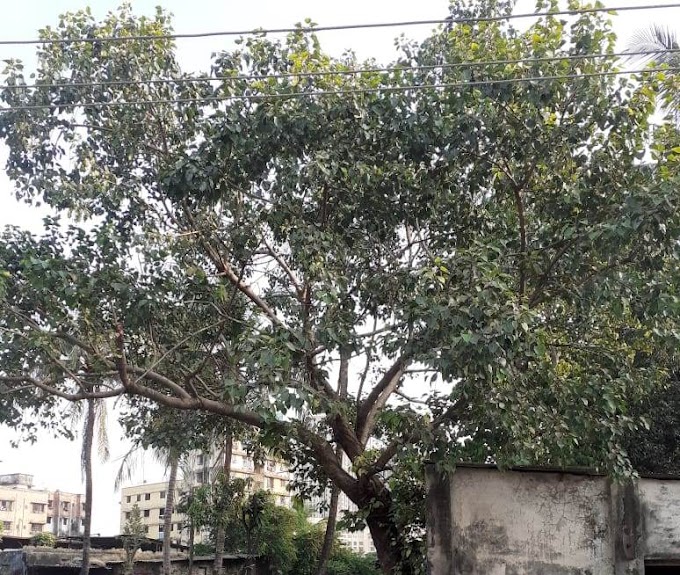About coconut tree in English
Here you will gate coconut tree information or you will
know about the coconut tree in English. Coconut is called as Narial in Hindi. The scientific name of coconut is Cocos nucifera L. As well as you will know about coconut leaves, coconut
flowers, the fruit of the coconut, coconut plant, coconut tree uses, etc.
 |
| Coconut Tree |
The coconut tree also named Nux Indica, Tree of life, Nariyal, Thenga, and jawz hindī. Name coconut comes from the old Spanish and Portuguese word coco. Coco means Skull or head.
Since the three indentations on
the coconut shell resemble facial features or skull or head. Coconuts are a
cultural icon of the tropics and ubiquitous in coastal tropical regions.
Human beings are using coconut for thousands of years. The
origin of coconut is a disputed subject. Its origin is either Asia or South
America, or on islands in the Pacific.
It is to be said that the coconut tree was present in the Indian
subcontinent before the 1st century BCE. Around 545 the Cosmas Indicopleustes
mentioned coconut as "the great nut of India" in his Topographia
Christiana. That is the first or earliest direct description of coconut in
Indian literature.
Sindbad sailor’s story "One Thousand and One
Nights" is another early mention of literary evidence. In this story,
Sindbad on his fifth voyage bought and sold a coconut.
Religious as well as the cultural significance of coconut
is there in certain societies. Coconut is used in Hindu rituals in India. It is
used in wedding and worship rituals in Hinduism. It also features in the origin
myths of several societies of Vietnam.
A palm tree family member coconut is the only living
species of the genus Cocos. And term coconut can be referred to whole coconut
palm, the seed, or the fruit.
The coconut tree gives 75 fruits per year and it grows up
to 30 meters tall. Full sunlight and
copious precipitation are preferable for Coconut trees. Cold weather is
intolerant for the Coconut tree.
Coconut species are affected by many diseases and insects
and are harmful to commercial production. India, Indonesia, and the Philippines
are supplying 74% of the world's supply of coconuts.
Scientific name of coconut tree/coconut tree scientific name
Cocos nucifera L is the scientific name of coconut tree. Cocos nucifera var. synphyllica Becc ,
Calappa Nucifera (L.) Kuntze, Cocos nana Griffith, Cocos indica Royle, are some
other scientific names of coconut.
A palm tree family member coconut is the only living species of the genus Cocos. And term coconut can be referred to whole coconut palm, the seed, or the fruit.
 |
| Coconut |
A palm tree family member coconut is the only living species of the genus Cocos. And term coconut can be referred to whole coconut palm, the seed, or the fruit.
Coconut Plant
The coconut plant or tree is a tall tree and it grows up to 100 feet
around 30 meters. Its pinnate leaves are 4 – 6 meters long and pinnae 60–90 cm
(2–3 feet) long.
In growing conditions after giving proper care, it produces its first fruits in six to ten years. For peak production 15 to 20 years required.
In growing conditions after giving proper care, it produces its first fruits in six to ten years. For peak production 15 to 20 years required.
Old leaves of this tree break cleanly and fall down,
leaving the trunk smooth. Mature coconut tree often gives less than 30 fruits
per year but it can give up to 75 fruits per year.
King coconut, and Macapuno and Maypan coconut and more
varieties are grown. The color of the fruit, the taste of coconut water, and
other genetic factors vary. Dwarf varieties of the coconut tree are also
available.
About Coconut Tree
The classification of the coconut plant is done on the basis of its
stature or height. The first is Tall palms and the second is Dwarf palms.
Tall palms: are widely planted commercially as well as
households. They flower after 6 – 10 years of planting as they are slow
maturing. And grow up to a height of 20-30 meters.
The economic life of this type of coconut is 60 – 70 years. They are long-lived, normally cross-pollinating, and therefore considered to be heterozygous.
The economic life of this type of coconut is 60 – 70 years. They are long-lived, normally cross-pollinating, and therefore considered to be heterozygous.
Dwarf palms: these are mutants from tall types with short
stature. At the age of 20 years 8 – 10 meters. They start flowering at the age
of 3 years and less than one-meter height.
Compare to tall palm dwarf palms have a short productive life of 30-40 years. Dwarf palms are self-pollinating and hence considered to be homozygous.
Compare to tall palm dwarf palms have a short productive life of 30-40 years. Dwarf palms are self-pollinating and hence considered to be homozygous.
Parts of coconut tree
The following are the parts of the coconut tree. Almost all
parts are used by human beings.
- The husk.
- The shell.
- The flesh.
- The water.
- The leaves.
- The heart.
- Spathe and inflorescence.
- The trunk.
- The roots
Leaves of coconut tree
In the beginning, leaves of coconut trees are in the form of pinnae
fused together and appear as entire leaves. When 8 - 10 leaves formed they tend
to split into leaflets.
Then stem starts to form with a single terminal growing point where new leaves develop. A common adult coconut tree produces twelve to sixteen leaves per year.
 |
| Leaves of a coconut tree |
Then stem starts to form with a single terminal growing point where new leaves develop. A common adult coconut tree produces twelve to sixteen leaves per year.
Thirty to forty leaves are there in one crown. And the same
number of leaf primordia. And a 'sword leaf' is emerging in it before 30
months. A mature leaf of coconut has around 200-250 leaflets and is about 3 - 4
long.
Three years is the life span of the leaf of coconut. After
three years its sheds and left a permanent scar on the trunk.
Coconut Flowers (Inflorescence)
In coconut plants, Flowering occurs continuously. The
coconut tree is monoecious. It produces males as well as females both flowers
on the same inflorescence. Sometimes it produces bisexual flowers.
 |
| Coconut Flowers |
Hence it may be polygamomonoecious. The male flower is much smaller than the female flower. In coconut some dwarf varieties are self-pollinating otherwise they are largely cross-pollinated.
Fruit of coconut
A full-grown full-sized fruit of coconut weighs about 1.4 kg. And it
has been estimated that around 6000 full-grown coconuts to produce one tone of
copra.
Coconut has three layers exocarp, mesocarp, and endocarp
like other fruits. Hence botanically it is not a true nut. It is a drupe. The
husk of the coconut is exocarp and mesocarp.
The endosperm of coconut is its nuclear phase and suspended within the coconut water. With the development of cellular layers of endosperm deposit along the walls of the coconut. It then becomes edible coconut "flesh".
 |
| Fruit of Coconut |
The endosperm of coconut is its nuclear phase and suspended within the coconut water. With the development of cellular layers of endosperm deposit along the walls of the coconut. It then becomes edible coconut "flesh".
Outmost layer exocarp is often removed in coconuts sold in
the shops of non-tropical countries. The mesocarp, called coir is composed of
fiber. Coir has many traditional and commercial uses.
When we remove the husk from the shell, three eyes are
clearly visible for us. These three eyes are germination pores or micropyles.
Coconut Trunk
The coconut trunk is cylindrical in shape. In rural areas,
the trunks of coconut trees were turns into planks. These trunks were used to
board and partition houses. They were also used as great pillars.
Coconut tree root
The coconut tree root system is a fibrous root system. There are a large number
of roots in coconut. Coconut tree roots are thin and grow outward from the plant near the
surface. Some of the roots penetrate deep into the soil for stability.
This type of root system is a characteristic of grass species and is called as the fibrous or adventitious root system. The tree grows new roots regularly and hence decayed roots are replaced.
 |
| Coconut tree roots |
This type of root system is a characteristic of grass species and is called as the fibrous or adventitious root system. The tree grows new roots regularly and hence decayed roots are replaced.
Coconut tree height
A coconut tree is a tall tree and it grows up to 100 feet
around 30 meters. The number of leaf scars on the stem can be correlated to
find the age of adult coconut trees.
The approximate age of the palm in years can be found by
dividing 13 to the number of scars on the stem. This may be important in
estimating the age of existing palms used as parent materials inbreeding.
Coconut cultivation
A hot and wet tropical climate is necessary for coconut
cultivation. Warmth and moisture are needed around the year to grow well the
plant as well as its fruit.
It is very difficult
to establish coconut in a dry climate. In drought conditions, fruit tends to be
shed. Older leaves become desiccated and
the new leaves do not open well.
Hence in a dry climate frequent irrigation is necessary.
Cultivation extent in the tropics is in danger as the number of habitats, such
as mangroves.
Coconut Cultivars
A number of traditional as well as commercial cultivars of
coconut. Such as tall cultivars, dwarf cultivars, and hybrid cultivars (hybrids
between tall and dwarfs). Different cultivars have different qualities.
West coast tall cultivar from India is more drought
resistant. Hainan Tall' cultivars from China are colder tolerant. Jamaican tall
dwarf cultivars are highly affected by the plant disease while Malayan dwarf
has shown some promising resistance to the same lethal yellowing disease
.
.
Weight, shape, and seed size and copra thickness are
important aspects in the selection of cultivars. In India and Sri Lanka ‘Fiji
dwarf ‘cultivars used entirely in fruit stalls. They produce very sweet coconut
water with orange-colored husks (king coconut).
Coconut tree plantation
The propagation of coconut is done by seedlings. These
seedlings are raised from selected seed nuts. Nine to twelve-month-old
seedlings are used for planting.
Among 9 – 12-month-old seedlings, select seedlings which have 6 -8 leaves and 10 – 12 cm collar girth.
 |
| Coconut tree plantation |
Among 9 – 12-month-old seedlings, select seedlings which have 6 -8 leaves and 10 – 12 cm collar girth.
Rocky and shallow soil sites should be avoided as low-lying
areas form water stagnation. It forms clay, and clay soil should be avoided in
a coconut plantation.
The coconut tree plantation site should have a proper supply of moisture. It may through well-distributed rainfall or through irrigation.
The coconut tree plantation site should have a proper supply of moisture. It may through well-distributed rainfall or through irrigation.
1mx1mx1m pit size is recommended in loamy soils with a low
water table. 1.2m x 1.2m x 1.2m pit is
recommended in laterite soils with underlying rocks. And less than 0.75m x
0.75m x 0.75 m pit size is needed in sandy soils.
In planting, spacing depends upon the planting system, soil type, etc. 7.6-meter distance between two seedings are recommended.
In planting, spacing depends upon the planting system, soil type, etc. 7.6-meter distance between two seedings are recommended.
Pits should be filled with topsoil and powdered cow dung.
It should be composted up to a depth of 50 to 60 cm. Then to accommodate the
nut attached to the seedling take small pit inside.
Then plant seeding in a small pit and fill up with soil. To
avoid water stagnation, press the soil well. In the case of a white ant attack
is expected, then apply 5 grams of Sevidol 8G inside the small pit before planting.
To improve the physical condition in laterite areas, apply
2 kg common salt per pit. It is also recommended to bury 25 to 30 coconut husks
per pit in layers. That will help in moisture conservation.
After planting, the first two years seeding should be
irrigated twice a week during the dry season. To the transplanted seedlings shading
must be done. To achieve higher productivity from the first-year Regular
manuring is essential.
Rhinoceros beetle, the red palm weevil, the black-headed
caterpillar, the cockchafer beetle, and the coreid bug are the major insect
pests of the coconut palm.
To control it we should hook out the beetle with the help
of beetle hook, from the attacked palms. We can fill up the topmost three-leaf
axils with fine sand (200g) + Sevidol 8G(25g) thrice in April, September, and
December as a prophylactic measure.
We can also place 10.5g naphthalene balls in the leaf
axils. And then cover it with fine sand. To destroy the larva, it is to be
practice to spray 0.01% Carbaryl (50WP) in the breeding sites of the beetle
once in 45 days.
Uses of coconut tree or Use of coconut tree
Coconut the most useful tree in the world is popularly
known as “Kalp Wruksh” or tree of life. Almost every part of this tree has been
used by humans. It serves human beings in many forms.
Among many other uses, some of these are folk medicine, fuel, food, cosmetics, and building materials. Coconut milk extracted from and the inner flash called ‘copra’ is the regular part of the diets of many people in the tropics and subtropics.
 |
| Coir |
Among many other uses, some of these are folk medicine, fuel, food, cosmetics, and building materials. Coconut milk extracted from and the inner flash called ‘copra’ is the regular part of the diets of many people in the tropics and subtropics.
Ripe and Matured coconut are used as edible seed and its
dried flesh is called copra. It is also processed for oil and plant milk from
the flesh.
Oil and milk derived from it are used in soaps and cosmetics. It is also commonly used in frying in particular in cooking.
Oil and milk derived from it are used in soaps and cosmetics. It is also commonly used in frying in particular in cooking.
Coir is obtained from the fibrous husk and Charcoal is
obtained from the hard shell.
Long pinnacle lives, fibrous husks, and hard shells can be
used as material to make a variety of products. Such as for furnishing and decoration.
Coconut water nutrition
Coconut
water is a natural beverage and a good source of many nutrients, which is
delicious, nutritious, and extremely good for us. It may have antioxidant
properties.
 |
| Drinking Coconut water |
It
may benefit against Diabetes, may prevent kidney stones, may reduce blood
pressure, and may support heart health. Coconut water is a delicious source of
hydration. It may beneficial after Exercise.
A
well develops green coconut fruit contains 0.5 to 1 cup (240 milliliters) of
coconut water. In one cup of coconut water nutrition contains 46 calories.
Apart
from this, it contains, Proteins 2 grams, Fiber 3 grams, carbs 9 grams, 10 % of
the RDI Vitamin C, 6% of the RDI Calcium, 11% of the RDI Sodium, 17% of the RDI
Potassium, 17% of the RDI Manganese, and 15% of the RDI Magnesium.
Coconut milk nutrition
Coconut
milk is obtained from the white coconut meat or coconut flesh of coconut fruit.
Coconut meat or coconut flesh mixed in water to make coconut milk.
Coconut
milk contains around 50% of water. It has a rich, creamy texture with a thick
consistency. It is a calorie-rich food that contains high levels of saturated
fat.
 |
| Coconut Milk |
Coconut
milk is a good source of several vitamins and minerals It may benefit in weight
loss as well as its benefits in heart health. It also boosts the immune system.
Coconut
milk nutrition may vary by product. In general, one cup of coconut milk (240
grams) contains 552 calories. It contains Fiber 5 grams, Carbs 13 grams,
Protein 5 grams, Fat 57 grams.
It also contains 11% of the RDI Vitamin C, 21% of the RDI
Selenium, 110% of the RDI Manganese, 32% of the RDI Copper, 18% of the RDI
Potassium, 22% of the RDI Magnesium, 22% of the RDI Iron and 10% of the RDI
Folate.
Conclusion
 |
| Coconut Dessert |
Coconut oil, coconut water, coconut milk, copra or coconut meat, coir, folk medicine, fuel, food, cosmetics, and building materials and several other products have been made from a coconut tree.
Click to Read about Gulmohar Tree
Click to Read about Peepal Tree







0 Comments